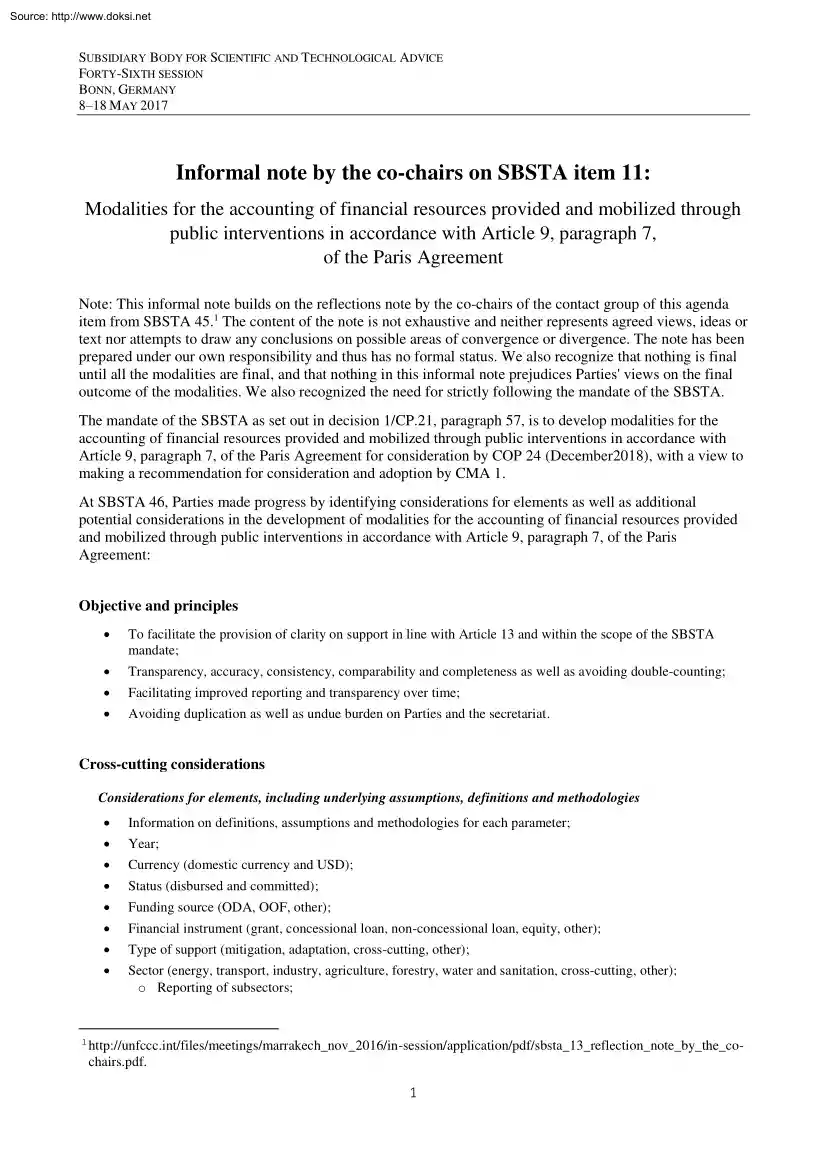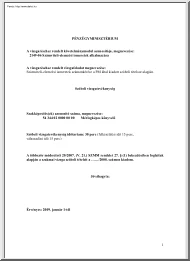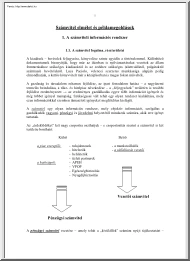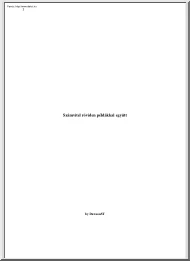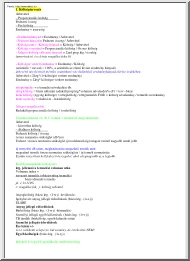Datasheet
Year, pagecount:2017, 3 page(s)
Language:English
Downloads:4
Uploaded:December 25, 2017
Size:720 KB
Institution:
-
Comments:
Attachment:-
Download in PDF:Please log in!
Comments
No comments yet. You can be the first!Most popular documents in this category
Content extract
Source: http://www.doksinet SUBSIDIARY BODY FOR SCIENTIFIC AND TECHNOLOGICAL ADVICE FORTY-SIXTH SESSION BONN, GERMANY 8–18 MAY 2017 Informal note by the co-chairs on SBSTA item 11: Modalities for the accounting of financial resources provided and mobilized through public interventions in accordance with Article 9, paragraph 7, of the Paris Agreement Note: This informal note builds on the reflections note by the co-chairs of the contact group of this agenda item from SBSTA 45.1 The content of the note is not exhaustive and neither represents agreed views, ideas or text nor attempts to draw any conclusions on possible areas of convergence or divergence. The note has been prepared under our own responsibility and thus has no formal status. We also recognize that nothing is final until all the modalities are final, and that nothing in this informal note prejudices Parties views on the final outcome of the modalities. We also recognized the need for strictly following the mandate of the
SBSTA The mandate of the SBSTA as set out in decision 1/CP.21, paragraph 57, is to develop modalities for the accounting of financial resources provided and mobilized through public interventions in accordance with Article 9, paragraph 7, of the Paris Agreement for consideration by COP 24 (December2018), with a view to making a recommendation for consideration and adoption by CMA 1. At SBSTA 46, Parties made progress by identifying considerations for elements as well as additional potential considerations in the development of modalities for the accounting of financial resources provided and mobilized through public interventions in accordance with Article 9, paragraph 7, of the Paris Agreement: Objective and principles To facilitate the provision of clarity on support in line with Article 13 and within the scope of the SBSTA mandate; Transparency, accuracy, consistency, comparability and completeness as well as avoiding double-counting; Facilitating improved reporting
and transparency over time; Avoiding duplication as well as undue burden on Parties and the secretariat. Cross-cutting considerations Considerations for elements, including underlying assumptions, definitions and methodologies 1 Information on definitions, assumptions and methodologies for each parameter; Year; Currency (domestic currency and USD); Status (disbursed and committed); Funding source (ODA, OOF, other); Financial instrument (grant, concessional loan, non-concessional loan, equity, other); Type of support (mitigation, adaptation, cross-cutting, other); Sector (energy, transport, industry, agriculture, forestry, water and sanitation, cross-cutting, other); o Reporting of subsectors; http://unfccc.int/files/meetings/marrakech nov 2016/in-session/application/pdf/sbsta 13 reflection note by the cochairspdf 1 Source: http://www.doksinet SUBSIDIARY BODY FOR SCIENTIFIC AND TECHNOLOGICAL ADVICE FORTY-SIXTH SESSION BONN,
GERMANY 8–18 MAY 2017 Enhancement of an electronic reporting application that facilitates the provision of project- and activity-level information by Parties (i.e the direct transfer of information from other data sources to the system under the Convention) to enhance and simplify access to and provision of information; Drawing from relevant work, including lessons learned, within and outside the Convention related to the modalities for the accounting of financial resources, in particular the recommendations of the 2016 BA summary and recommendations; When and how the modalities for the accounting of financial resources provided and mobilized through public interventions developed by the SBSTA could be incorporated into the modalities, procedures and guidelines for the transparency framework developed by the APA. Additional potential considerations: Clarity on what counts as climate finance, for example: through an operational/working definition? through
provision of information on boundaries/criteria such as climate relevance and the geographical origin? through funding of NDCs? How the climate finance counted is new and additional; Harmonization of reporting approaches across Parties: o Which currency exchange rates to use; o How to count finance committed and/or disbursed; o How to report funding sources; Provision of references to official documentation to indicate the status of funds (disbursed/committed); How to report various financial instruments, for example, the reporting of the grant-equivalent/net value/face value when different financial instruments are used; Whether/how to make use of built-in options; Mutual agreement/cross-checking with recipients before submitting information; How to capture the notion of scale-up and progression of climate finance; Encouragement of all Parties that provide support to use the accounting modalities to facilitate the provision of as much
information as possible, while recognizing the mandatory and non-mandatory aspects; Any other considerations that may be relevant to accounting modalities: Article 9, paragraph 5, of the Paris Agreement; reporting on finance to loss and damage. Climate finance provided through bilateral, regional and other channels Considerations for elements, including underlying definitions, assumptions and methodologies: Recipient country/region/project/programme/activity: o How to facilitate more granularity through the provision of project- and activity-level information to enhance the transparency of operational definitions of climate finance used and to foster engagement between donor and recipient countries; Climate-specific: o More clarity on what each Party counts as climate finance (e.g through the indication of coefficients where Rio markers were used, through operational definitions of climate finance, criteria used to determine climate relevance). Additional potential
considerations: Tagging of activities that have a capacity-building and technology transfer component to facilitate better tracking and avoid double counting according to built-in options; Provision of information on transaction and overhead costs, loan repayments and return on investments; Provision of information on implementing agencies. 2 Source: http://www.doksinet SUBSIDIARY BODY FOR SCIENTIFIC AND TECHNOLOGICAL ADVICE FORTY-SIXTH SESSION BONN, GERMANY 8–18 MAY 2017 Climate finance provided through multilateral channels Considerations for elements, including underlying definitions, assumptions and methodologies: Multilateral climate change funds, as well as other climate change funds; multilateral financial institutions, including regional development banks; and specialized United Nations bodies; o Differentiation of reporting per subchannel; o Provision of information on bilateral funds provided through multilateral channels; Core/general: o
Reporting of only the climate-specific amount of core contributions (e.g through imputed multilateral contributions); o Avoidance of double counting; Climate-specific: o More clarity on the criteria used by Parties and international financial institutions to identify contributions and outflows, respectively, as being climate-specific. Additional potential considerations: Facilitation of understanding on the outflow of finance from multilateral channels to developing country Parties (e.g (1) through an invitation to multilateral financial institutions to provide project-level information by financial instrument and by recipient, as well as information on how climate-specific inflows relate to outflows going to climate change projects; (2) through the utilization of the Standing Committee on Finance’s biennial assessment and overview of climate finance flows as a vehicle; (3) through recipient country reporting). Climate finance mobilized through public interventions
Potential considerations, while recognizing challenges and limitations: Clear differentiation of mobilized climate finance and provided climate finance; Development of a common understanding of fundamental concepts such as mobilization; Harmonization of methodologies (e.g reporting on co-financing, causality and attribution); provision of definitions and approaches used Need for further discussions on the boundaries of tracking mobilized finance through public interventions, (e.g direct mobilization, indirect mobilization, transformational impact/enabling environments, capacity-building, technology transfer and public policies); Development of simple standardized/common reporting format to facilitate consistency of quantitative reporting across Parties; Provision of qualitative information such as good practices on public policy and regulatory frameworks incentivise further private climate financing and investments; Option for collective
reporting where the double counting risk is high; Building on existing studies and further inviting expert organizations to undertake technical work. ----- 3
SBSTA The mandate of the SBSTA as set out in decision 1/CP.21, paragraph 57, is to develop modalities for the accounting of financial resources provided and mobilized through public interventions in accordance with Article 9, paragraph 7, of the Paris Agreement for consideration by COP 24 (December2018), with a view to making a recommendation for consideration and adoption by CMA 1. At SBSTA 46, Parties made progress by identifying considerations for elements as well as additional potential considerations in the development of modalities for the accounting of financial resources provided and mobilized through public interventions in accordance with Article 9, paragraph 7, of the Paris Agreement: Objective and principles To facilitate the provision of clarity on support in line with Article 13 and within the scope of the SBSTA mandate; Transparency, accuracy, consistency, comparability and completeness as well as avoiding double-counting; Facilitating improved reporting
and transparency over time; Avoiding duplication as well as undue burden on Parties and the secretariat. Cross-cutting considerations Considerations for elements, including underlying assumptions, definitions and methodologies 1 Information on definitions, assumptions and methodologies for each parameter; Year; Currency (domestic currency and USD); Status (disbursed and committed); Funding source (ODA, OOF, other); Financial instrument (grant, concessional loan, non-concessional loan, equity, other); Type of support (mitigation, adaptation, cross-cutting, other); Sector (energy, transport, industry, agriculture, forestry, water and sanitation, cross-cutting, other); o Reporting of subsectors; http://unfccc.int/files/meetings/marrakech nov 2016/in-session/application/pdf/sbsta 13 reflection note by the cochairspdf 1 Source: http://www.doksinet SUBSIDIARY BODY FOR SCIENTIFIC AND TECHNOLOGICAL ADVICE FORTY-SIXTH SESSION BONN,
GERMANY 8–18 MAY 2017 Enhancement of an electronic reporting application that facilitates the provision of project- and activity-level information by Parties (i.e the direct transfer of information from other data sources to the system under the Convention) to enhance and simplify access to and provision of information; Drawing from relevant work, including lessons learned, within and outside the Convention related to the modalities for the accounting of financial resources, in particular the recommendations of the 2016 BA summary and recommendations; When and how the modalities for the accounting of financial resources provided and mobilized through public interventions developed by the SBSTA could be incorporated into the modalities, procedures and guidelines for the transparency framework developed by the APA. Additional potential considerations: Clarity on what counts as climate finance, for example: through an operational/working definition? through
provision of information on boundaries/criteria such as climate relevance and the geographical origin? through funding of NDCs? How the climate finance counted is new and additional; Harmonization of reporting approaches across Parties: o Which currency exchange rates to use; o How to count finance committed and/or disbursed; o How to report funding sources; Provision of references to official documentation to indicate the status of funds (disbursed/committed); How to report various financial instruments, for example, the reporting of the grant-equivalent/net value/face value when different financial instruments are used; Whether/how to make use of built-in options; Mutual agreement/cross-checking with recipients before submitting information; How to capture the notion of scale-up and progression of climate finance; Encouragement of all Parties that provide support to use the accounting modalities to facilitate the provision of as much
information as possible, while recognizing the mandatory and non-mandatory aspects; Any other considerations that may be relevant to accounting modalities: Article 9, paragraph 5, of the Paris Agreement; reporting on finance to loss and damage. Climate finance provided through bilateral, regional and other channels Considerations for elements, including underlying definitions, assumptions and methodologies: Recipient country/region/project/programme/activity: o How to facilitate more granularity through the provision of project- and activity-level information to enhance the transparency of operational definitions of climate finance used and to foster engagement between donor and recipient countries; Climate-specific: o More clarity on what each Party counts as climate finance (e.g through the indication of coefficients where Rio markers were used, through operational definitions of climate finance, criteria used to determine climate relevance). Additional potential
considerations: Tagging of activities that have a capacity-building and technology transfer component to facilitate better tracking and avoid double counting according to built-in options; Provision of information on transaction and overhead costs, loan repayments and return on investments; Provision of information on implementing agencies. 2 Source: http://www.doksinet SUBSIDIARY BODY FOR SCIENTIFIC AND TECHNOLOGICAL ADVICE FORTY-SIXTH SESSION BONN, GERMANY 8–18 MAY 2017 Climate finance provided through multilateral channels Considerations for elements, including underlying definitions, assumptions and methodologies: Multilateral climate change funds, as well as other climate change funds; multilateral financial institutions, including regional development banks; and specialized United Nations bodies; o Differentiation of reporting per subchannel; o Provision of information on bilateral funds provided through multilateral channels; Core/general: o
Reporting of only the climate-specific amount of core contributions (e.g through imputed multilateral contributions); o Avoidance of double counting; Climate-specific: o More clarity on the criteria used by Parties and international financial institutions to identify contributions and outflows, respectively, as being climate-specific. Additional potential considerations: Facilitation of understanding on the outflow of finance from multilateral channels to developing country Parties (e.g (1) through an invitation to multilateral financial institutions to provide project-level information by financial instrument and by recipient, as well as information on how climate-specific inflows relate to outflows going to climate change projects; (2) through the utilization of the Standing Committee on Finance’s biennial assessment and overview of climate finance flows as a vehicle; (3) through recipient country reporting). Climate finance mobilized through public interventions
Potential considerations, while recognizing challenges and limitations: Clear differentiation of mobilized climate finance and provided climate finance; Development of a common understanding of fundamental concepts such as mobilization; Harmonization of methodologies (e.g reporting on co-financing, causality and attribution); provision of definitions and approaches used Need for further discussions on the boundaries of tracking mobilized finance through public interventions, (e.g direct mobilization, indirect mobilization, transformational impact/enabling environments, capacity-building, technology transfer and public policies); Development of simple standardized/common reporting format to facilitate consistency of quantitative reporting across Parties; Provision of qualitative information such as good practices on public policy and regulatory frameworks incentivise further private climate financing and investments; Option for collective
reporting where the double counting risk is high; Building on existing studies and further inviting expert organizations to undertake technical work. ----- 3
